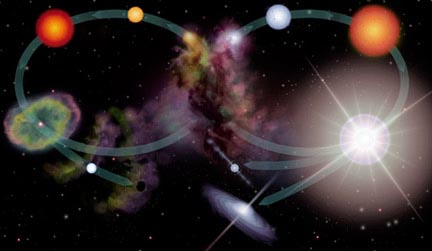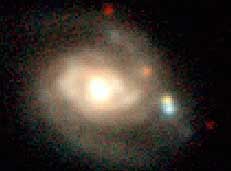
| It is very poetic to say that we are made from the dust of the stars. Amazingly, it's also true! Much of our bodies, and our planet, are made of elements that were created in the explosions of massive stars. Let's examine exactly how this can be. |
As the main sequence star glows, hydrogen in its core is converted into helium by nuclear fusion. When the hydrogen supply in the core begins to run out, and the star is no longer generating heat by nuclear fusion, the core becomes unstable and contracts. The outer shell of the star, which is still mostly hydrogen, starts to expand. As it expands, it cools and glows red. The star has now reached the red giant phase. It is red because it is cooler than it was in the main sequence star stage and it is a giant because the outer shell has expanded outward. All stars evolve the same way up to the red giant phase. The amount of mass a star has determines which of the following life cycle paths it will take from there.

The image above shows, on the left side, the cycle for low mass stars such as our Sun, which begin in nebulae (in the center), evolve towards and live in the Main sequence, expand to become red giants as they run out of nuclear fuel in their cores, and eventually fade away to become white dwarfs and then black dwarfs, cinders of stars. Stars like our Sun do not have enough mass to ever explode in a supernova. On the right is the life cycle of a massive star (10 times or more the size of our Sun). High-mass stars go through many of the same stages as a low-mass star, however, their life cycles start to differ after the red giant phase. A massive star will undergo a supernova explosion. If the remnant of the explosion is 1.4 to ~3 times as massive as our Sun, it will become a neutron star. Neutron stars spin rapidly giving off radio waves. If the radio waves are emitted in pulses (due to the star's spin), these neutron stars are called pulsars. The core of a massive star that has more than ~3 times the mass of our Sun after the explosion will do something quite differnt. No nuclear fusion is taking place to support the core, so it is swallowed by its own gravity. It has now become a black hole which readily attracts any matter and energy that comes near it. What happens between the red giant phase and the supernova explosion is described below.

|
When the core contains essentially just
iron, it has nothing left to fuse (because of iron's nuclear
structure, it cannot fuse into heavier elements in a self-sustaining
reaction). Fusion in the core ceases. In less than a second, the star
begins the final phase of gravitational collapse. The core temperature
rises to over 100 billion degrees as the iron atoms are crushed
together. The repulsive force between the nuclei overcomes the force
of gravity, and the core recoils out from the heart of the star in an
explosive shock wave, a supernova explosion.
Image Credit: C. Hergenrother, Whipple Observatory, P. Garnavich, P.Berlind, R.Kirshner (CFA). The two supernovae, one reddish yellow and one blue, form a close pair just below the image center (to the right of the galaxy nucleus). |
As the shock encounters material in the star's outer layers, the material is heated, fusing to form new elements and radioactive isotopes. While many of the more common elements are made through nuclear fusion in the cores of stars, it takes the unstable conditions of the supernova explosion to form many of the heavier elements. The shock wave propels this material out into space. The material that is exploded away from the star is now known as a supernova remnant.
The hot material, the radioactive isotopes, as well as the leftover core of the exploded star, produce X-rays and gamma-rays.
| Using the above background information, (and additional sources of information from the library or the web), make your own diagram of the life cycle of a high-mass star. |
| Using the text, and any external printed references, define the following terms: protostar, life cycle, main sequence star, red giant, white dwarf, black dwarf, supernova, neutron star, pulsar, black hole, fusion, element, isotope, X-ray, gamma-ray. |
Supernovae
http://imagine.gsfc.nasa.gov/docs/science/know_l1/supernovae.html
http://imagine.gsfc.nasa.gov/docs/science/know_l2/supernovae.html
Life Cycles of Stars
http://imagine.gsfc.nasa.gov/docs/teachers/lifecycles/stars.html